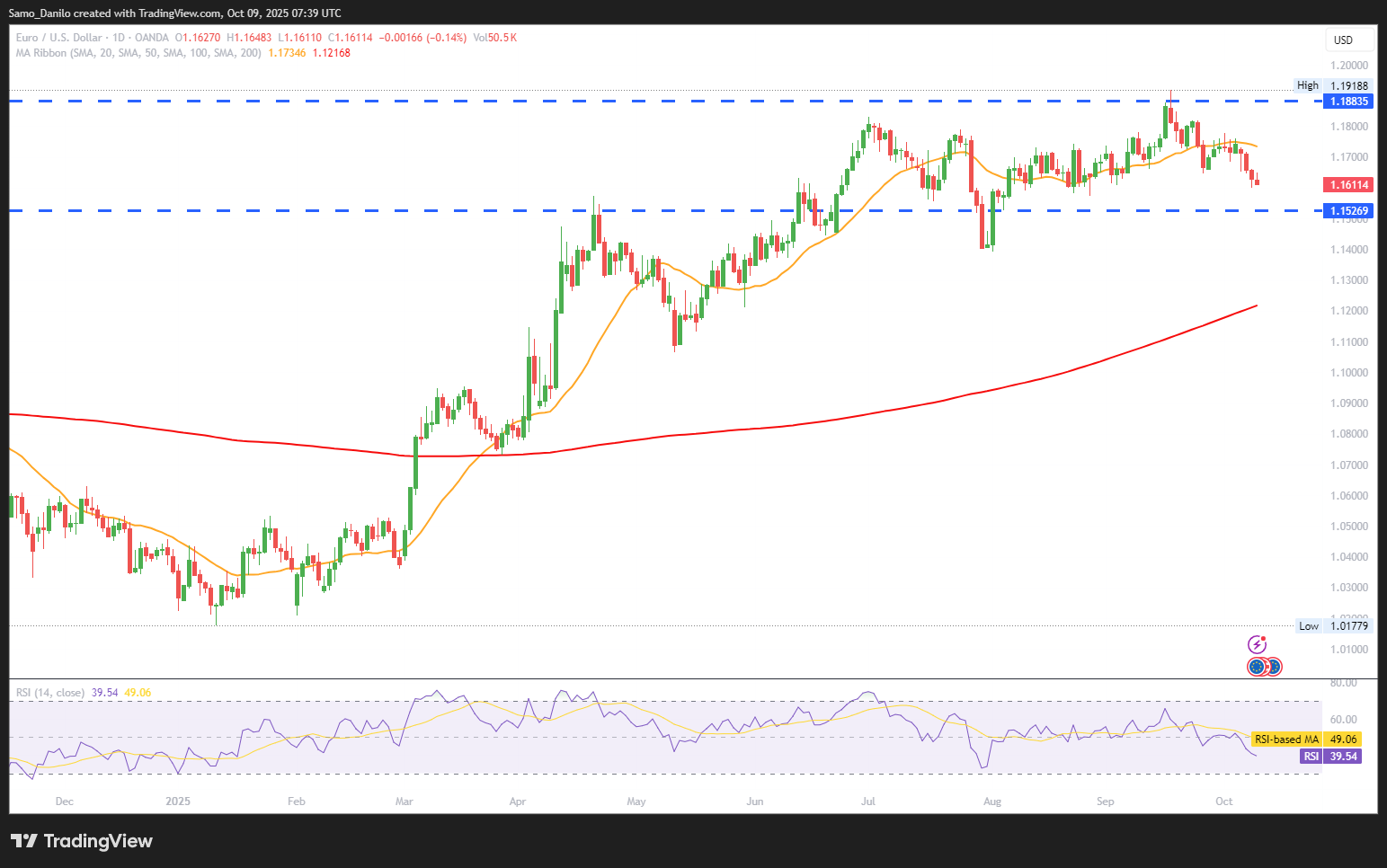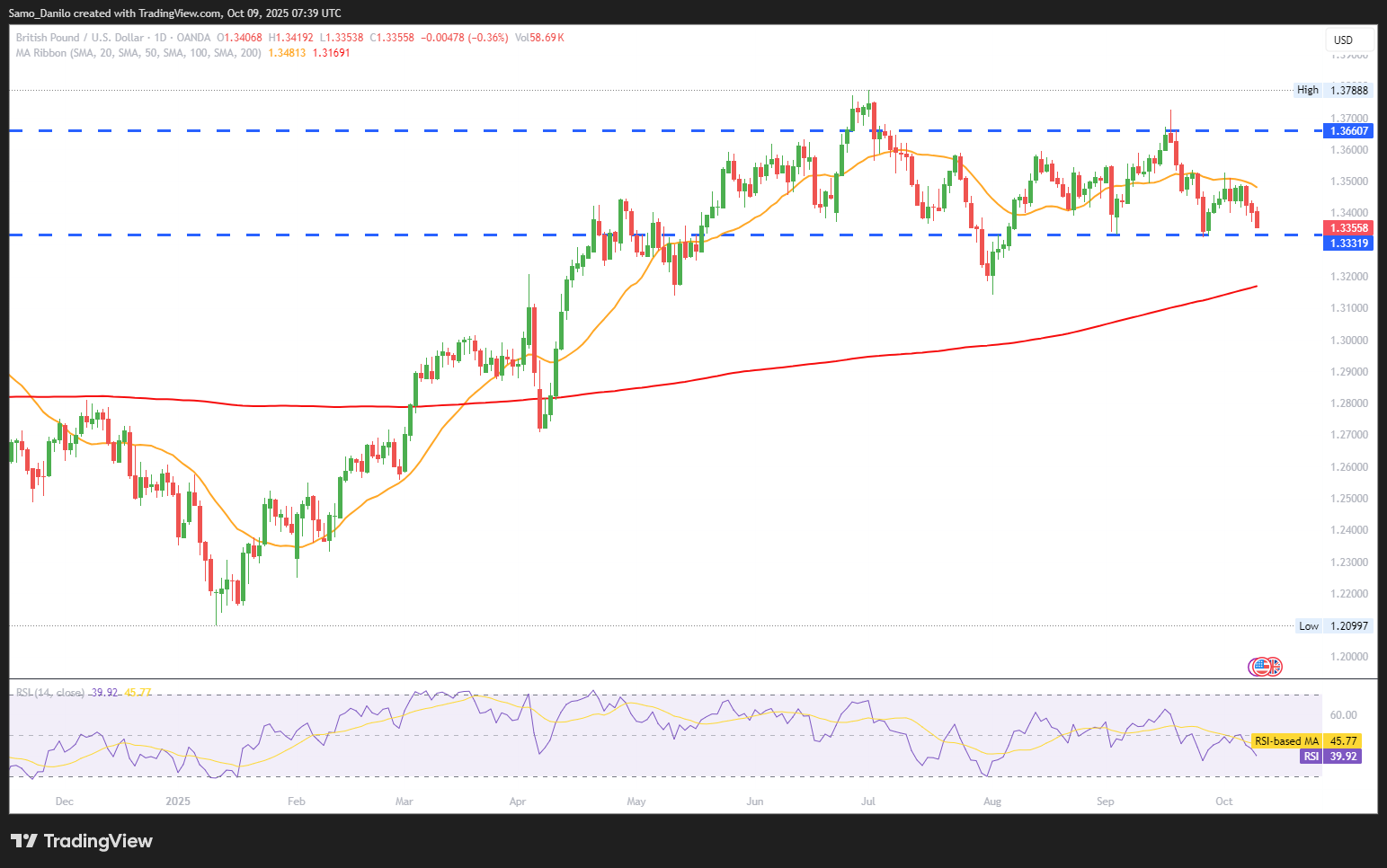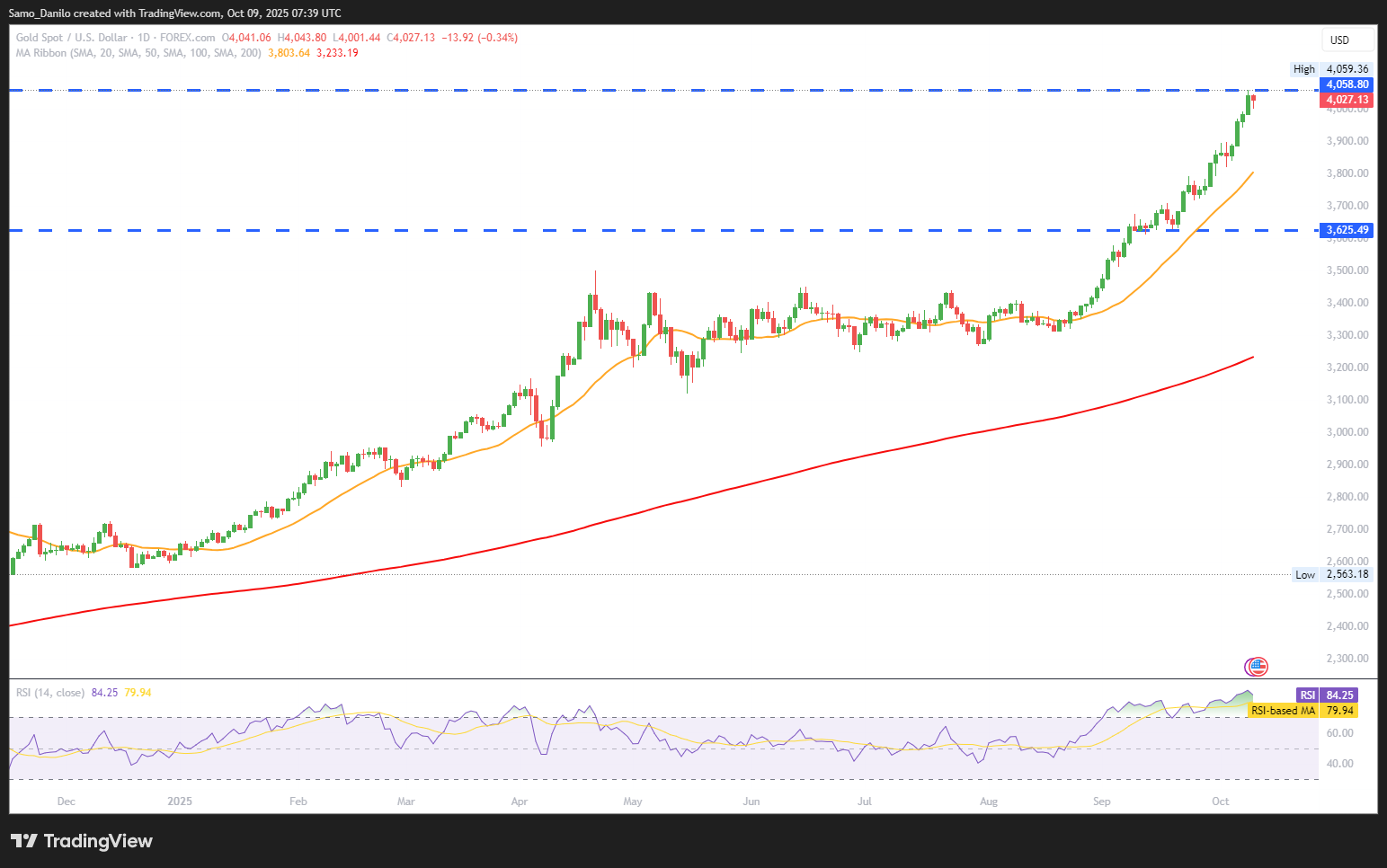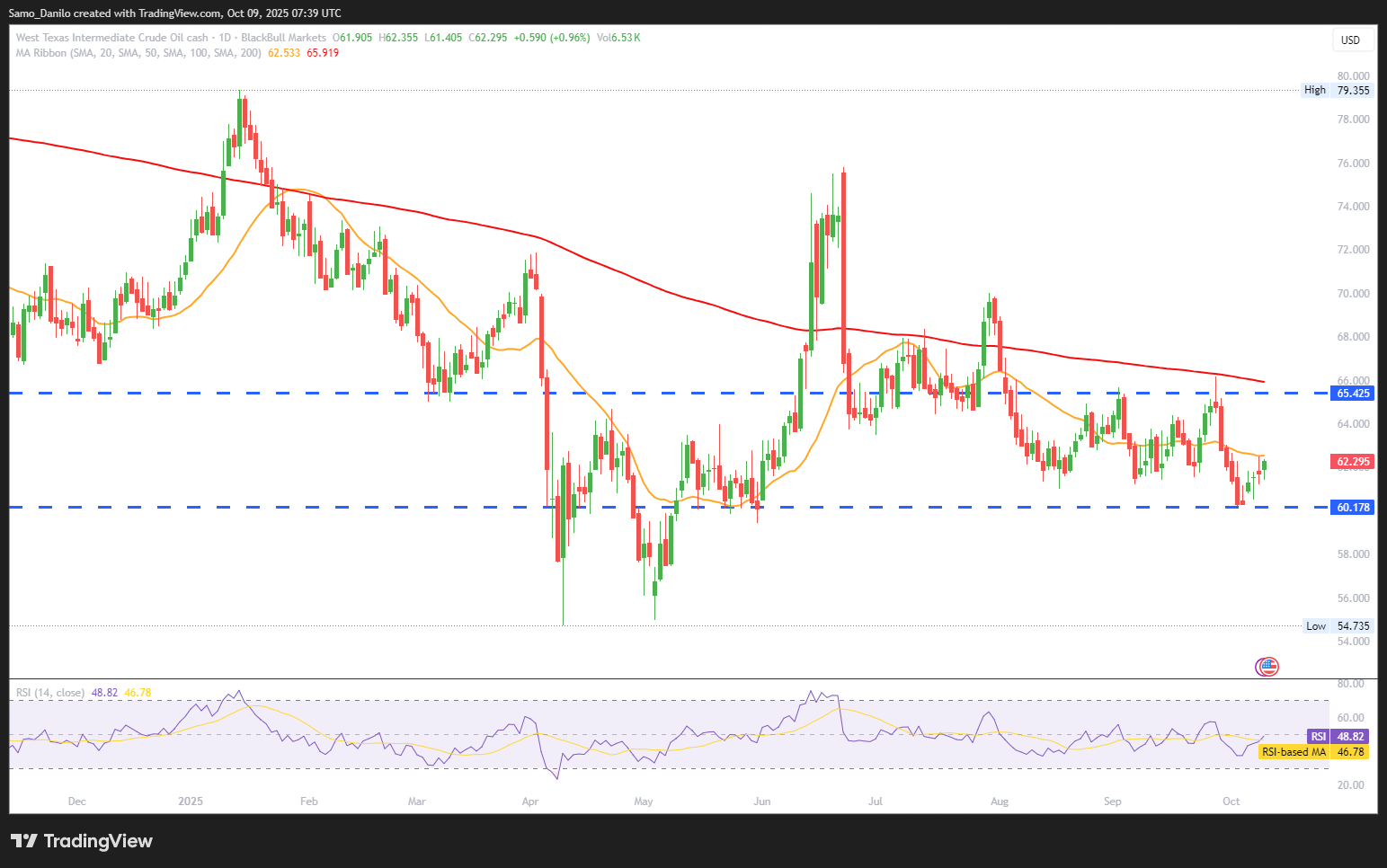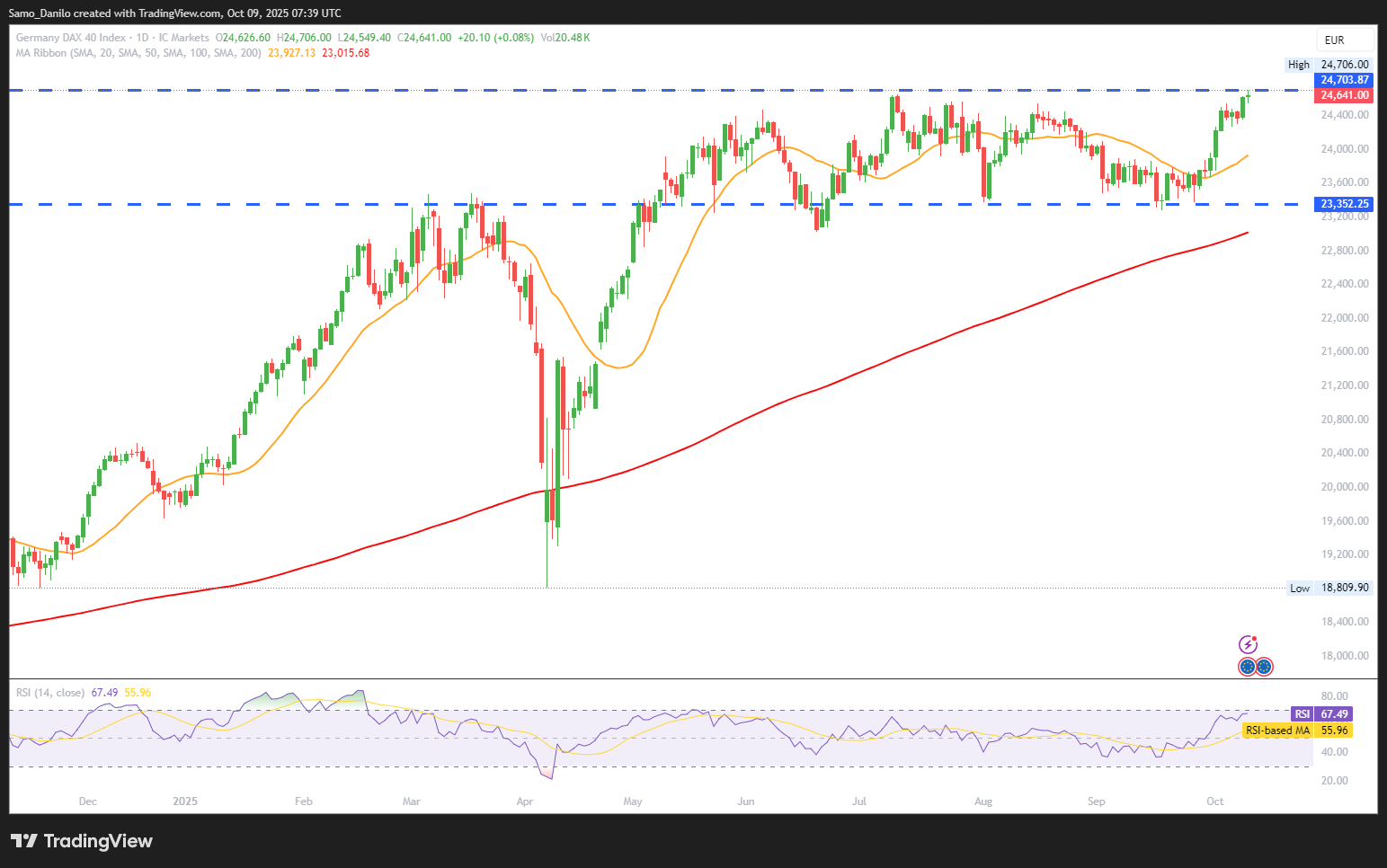EURUSD
- EUR/USD Price: The EUR/USD pair rebounds to around 1.1630, ending a three-day losing streak during Thursday’s European session. The recovery follows stabilization in ECB commentary and some technical buying interest near recent lows.
- Political Developments: Outgoing Prime Minister Sébastien Lecornu emphasized the urgency for France to approve a budget by year-end, noting positive momentum in parliamentary talks. He is expected to present progress details to President Macron later today, aiming to restore fiscal stability amid ongoing political turbulence.
- ECB's Escrivá: ECB’s José Luis Escrivá stated that interest rates are currently at appropriate levels, adding that there is no need for further forward guidance given the uncertain economic environment. His remarks suggest a wait-and-see stance within the ECB.
- ECB's Rehn: Olli Rehn highlighted visible medium-term downside risks despite the current favorable outlook, reinforcing his dovish policy bias.
- ECB's Muller: Conversely, Georg Muller remarked that inflation is at the desired level, echoing the broader ECB consensus to maintain current policy settings while monitoring future data.
Closing statement: The euro’s recovery remains fragile, supported by stable ECB rhetoric and political reassurances from France, but capped by ongoing uncertainty in growth outlooks and broader USD strength. Markets appear poised for range trading near 1.16 until fresh catalysts emerge.
GBPUSD
- GBP/USD Price: The GBP/USD pair remains under pressure, extending its decline around 1.3395 during Thursday’s European session. The pair faces renewed selling interest as investors favor the US Dollar amid persistent risk aversion and global uncertainty.
- BoE Commentary: Bank of England Chief Economist Huw Pill emphasized the need for a “conservative” approach to monetary policy, warning that policymakers must be ready to act decisively if inflation accelerates again. His remarks underscore the BoE’s cautious stance in balancing growth risks against price pressures.
- BoE Report: The latest FPC Record highlighted that UK households and businesses remain broadly resilient despite facing higher living costs and borrowing expenses. However, the Committee maintained a vigilant tone, acknowledging potential vulnerabilities in credit conditions and asset valuations.
- Shutdown Impact: The US federal government shutdown has now entered its ninth day, with the Bureau of Labor Statistics (BLS) and Bureau of Economic Analysis (BEA) halting data collection. This disruption limits the Fed’s access to real-time data, complicating both monetary policy assessments and business planning.
- BoE Outlook: The Bank of England warned of potential global market instability if investor enthusiasm toward artificial intelligence (AI) reverses abruptly. The IMF echoed this concern, while the BoE’s FPC also cited rising worries about US central bank independence as a possible trigger for a broader market correction.
Closing statement: The Pound remains pressured, weighed by BoE caution and global financial market risks, while the prolonged US government shutdown continues to distort sentiment. Near-term direction will hinge on Fed-related developments and UK inflation data, with the pair likely to remain range-bound below 1.34 until fresh catalysts emerge.
XAUUSD
- XAU/USD Price: Gold (XAU/USD) found renewed buying interest near the $4,000 psychological level, reversing most of its early Asian-session losses. The metal’s resilience reflects continued safe-haven demand amid geopolitical and policy uncertainty, while traders position ahead of fresh cues from the Federal Reserve.
- Fed Minutes: Minutes from the Fed’s September meeting indicated that a majority of policymakers supported the latest rate cut and signaled openness to further easing later this year. The dovish tone bolstered demand for non-yielding assets such as gold, reinforcing its upside momentum around record levels.
- Middle East: US President Donald Trump announced progress in Gaza peace talks, stating that Israel and Hamas had agreed on the first phase of his 20-point peace plan following negotiations in Egypt. This modest de-escalation provided temporary relief to markets but did little to dent gold’s risk-hedge appeal.
- US–Russia Tensions: A senior Russian lawmaker warned that Moscow would shoot down Tomahawk missiles and strike their launch sites if the US delivers them to Ukraine. The remarks further escalated tensions between the two nuclear powers, adding a layer of geopolitical risk premium to gold prices.
- Powell’s Remarks: With no major US data releases due to the ongoing government shutdown, traders’ attention turns to Fed Chair Jerome Powell’s upcoming comments, seeking clarity on the timing and scale of potential rate cuts. His tone will likely shape gold’s near-term direction.
Closing statement: • West Texas Intermediate (WTI) Oil price advances on Thursday, early in the European session. WTI trades at $62.20 per barrel, up from Wednesday’s close at $61.92.
CRUDE OIL
- Crude Oil Price: West Texas Intermediate (WTI) crude oil extended its rebound early Thursday in Europe, trading near $62.20 per barrel, up modestly from Wednesday’s close at $61.92. The slight uptick reflects short-term buying interest despite growing market concerns over rising inventories and potential oversupply.
- EIA Data: The latest US Energy Information Administration (EIA) report showed that crude stockpiles rose by 3.715 million barrels for the week ending October 3, a much larger build than the prior week’s 1.792 million barrels. The data reinforced a bearish supply narrative, suggesting demand may not be keeping pace with production levels.
- Demand Indicator: The same EIA report noted that total petroleum products supplied, a key proxy for US oil consumption, jumped to 21.99 million barrels per day, marking the highest reading since December 2022. While this uptick signals robust domestic demand, the overall inventory build implies continued imbalances in supply chains.
- Market Sentiment: Citi analysts warned that oil market sentiment is turning bearish, pointing to persistent signs of oversupply. According to Bloomberg, benchmark prices are down roughly 10% year-to-date, with Brent crude posting back-to-back monthly losses in August and September, underscoring waning market confidence.
- OPEC+ Policy: Earlier this week, OPEC+ confirmed a modest production increase of 137,000 barrels per day (bpd) for November. The decision, framed as a cautious adjustment, reflects member concerns over a potential market glut but also hints at an internal compromise to maintain price stability amid mixed demand signals.
Closing statement: WTI remains range-bound near $62 as traders weigh rising US inventories against solid consumption data. With OPEC+ output creeping higher and sentiment turning bearish, the market may face renewed downside pressure unless evidence of sustained demand recovery emerges in the coming weeks.
DAX
- DAX Price: The DAX index trades slightly higher at around 24,700 points, holding just above the previous day’s close. The index remains in positive territory, supported by global risk-on sentiment, even as domestic economic indicators point to growing weakness in Germany’s industrial sector.
- Technical Outlook: From a technical standpoint, the DAX’s structure appears constructive. The long-standing resistance zone near 24,650 has acted as a ceiling for months. A sustained breakout above this level could trigger short-covering and momentum buying, potentially propelling the index toward the next key target at 25,000 points.
- External Tailwinds: According to Landesbank Helaba, the DAX is gaining upward momentum from Wall Street, where both the S&P 500 and Nasdaq 100 hit new record highs overnight. Sentiment was further buoyed by the Japanese Nikkei index, which also reached a fresh all-time high, underscoring a global appetite for equities.
- Trade Data: German exports unexpectedly declined by 0.5% in August, missing expectations for a 0.3% rise. The drop was largely driven by a sharp fall in US demand, reflecting the impact of Washington’s tariffs on European imports. The data underscores the increasing trade headwinds facing Europe’s largest economy.
- Industrial Output: Germany’s industrial production fell back to 2005 levels in August, marking a stark setback for the manufacturing sector. Particularly concerning was the 18.5% monthly plunge in auto industry output, signaling deeper structural challenges for one of the country’s core economic pillars.
Closing statement: The DAX remains technically strong above 24,650, supported by global equity optimism, but domestic fundamentals are weakening sharply. Sustained momentum toward 25,000 will likely depend on external market strength and any signs of stabilization in Germany’s manufacturing and export performance.
